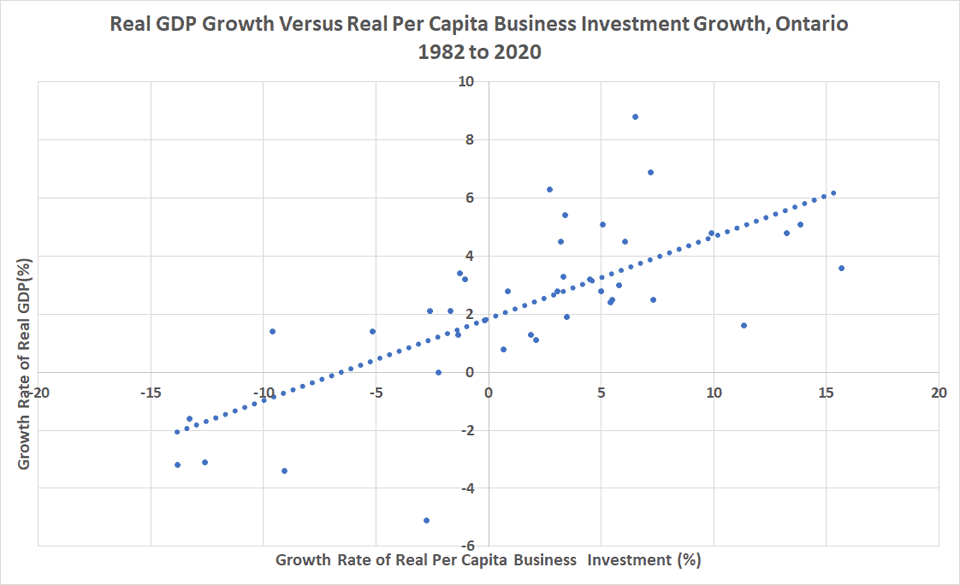Ontario needs more business investment during the recovery and beyond

Tomorrow (Nov. 4) Finance Minister Peter Bethlenfalvy will deliver Ontario’s 2021 fall economic outlook and fiscal statement, with a likely focus on the Ford government’s plan to deal with the continuing aftermath of the COVID-19 pandemic.
On the economic side, putting Ontario back on a path for sustained economic growth is paramount given the pandemic blows to the business sector. On the fiscal side, there’s an expected deficit in 2021-22 of more than $30 billion with deficits (as projected in the spring 2021 budget) continuing until 2028-29, bringing the provincial net debt to just short of $600 billion by the end of the decade. And then there’s the long-term fallout of the pandemic on health and education given the classroom disruption of the past two years and declines in health-care system activity because of COVID that resulted in a drop in emergency room visits, surgeries and physician visits.
But underlying all of this is the long-term weakening of Ontario’s economy in terms of its business investment performance. Investment in new plants, equipment and machinery is crucial to long-term growth in productivity and income. Here, Ontario has seen a gradual weakening in the strength of its business investment. While it’s true that business investment fluctuates with the business cycle, the average annual growth rate of real per-capita business investment has trended down despite a recovery during the last decade. When business investment is examined by category, further problems become apparent.
In Ontario’s historical economic accounts, business investment is subdivided into categories—residential structures, non-residential structures, intellectual property products and machinery, plants and equipment. In the 1980s, all four of these private investment cylinders fired together with real per-capita investment in residential structures growing at 6 per cent annually, non-residential structures at 4.7 per cent, intellectual property products at 6.5 per cent and machinery, plants and equipment at 6.8 per cent.
The 1990s were more mixed with real per-capita investment in residential and non-residential structures both declining at an annual average of -3 per cent. These investment components were hit hard by the high interest rates and recession of the early-1990s. However, machinery and equipment grew at nearly 5 per cent (a tooling up of Ontario manufacturing during the export boom of the late-1990s) and intellectual property products at almost 6 per cent.
The 2000s were also mixed with real per-capita investment in residential structures recovering somewhat and growing at an average of 1.5 per cent annually while intellectual property products grew at just over 3 per cent. Meanwhile both non-residential structures, and machinery and equipment saw average annual declines at about 2 per cent and .5 per cent respectively.
As for the period since 2010 (excluding pandemic year 2020), the province saw a recovery with all four components once again showing positive average annual growth. Real per-capita investment in residential structures grew at an average just below 2 per cent, non-residential structures at nearly 5 per cent with machinery and equipment at under 2 per cent and intellectual property product investment at just over 1 per cent.
Over the last 40 years, the most consistent positive performance in business investment growth has come in the intellectual property products category. Indeed, over the entire period from 1981 to 2019, real per-capita investment in this category has grown at an average annual rate of 3.8 per cent. This reflects Ontario’s new economy in information and software, although in 2019 it still only accounted for 13 per cent of all business investment in Ontario.
Investment in machinery, plants and equipment—a vital part of future manufacturing productivity—over this 40-year period grew next highest at 2.5 per cent annually but its share in 2019 was also only 20 per cent. As for real per-capita investment in non-residential structures, its historical long-term growth rate has been a mere seven-tenths of 1 per cent and it too is a relatively smaller fraction of total investment coming in at 22 per cent.
The lion’s share of business investment has always been and remains investment in residential structures, which in 2019 accounted for 45 per cent of business investment spending. And yet, its long-term average annual growth rate is also rather anemic at an average 1.4 per cent annually over the entire 40-year period. The growth rate in real per-capita residential investment in the 2010s has been barely one-third what it was in the bygone 1980s, providing another reason why residential home prices in Ontario have been skyrocketing in recent years. Supply of new housing has not grown very robustly (once inflation and population growth are considered) and yet this slowly growing business investment sector accounts for nearly half of Ontario’s business investment.
Clearly, the real problem is figuring out how to boost the growth rate of private-sector business investment in Ontario, because as the chart illustrates, there’s ultimately a very strong positive relationship between real per-capita business investment and the growth rate of total real GDP.

According to its spring 2021 budget, the Ontario government forecasts real GDP growth in 2021 at 4 per cent and 4.3 percent in 2022. Yet such a stellar performance would appear to require average growth in real per-capita business investment to approach 5 per cent annually, something that hasn’t happened as often in Ontario since the 1980s.
In fact, the 1980s saw real per-capita business investment grow at 5 per cent or more in six years, the 1990s in three years, the 2000s never and the 2010s to-date three times (though two of those were an immediate rebound after 2009 recession). It’s probably no surprise that the same spring 2021 budget sees real GDP growth then slowing to 2.5 per cent in 2023.
For Ontario’s economy to grow robustly in the post-pandemic era, policymakers must help get business investment up and roaring again.

